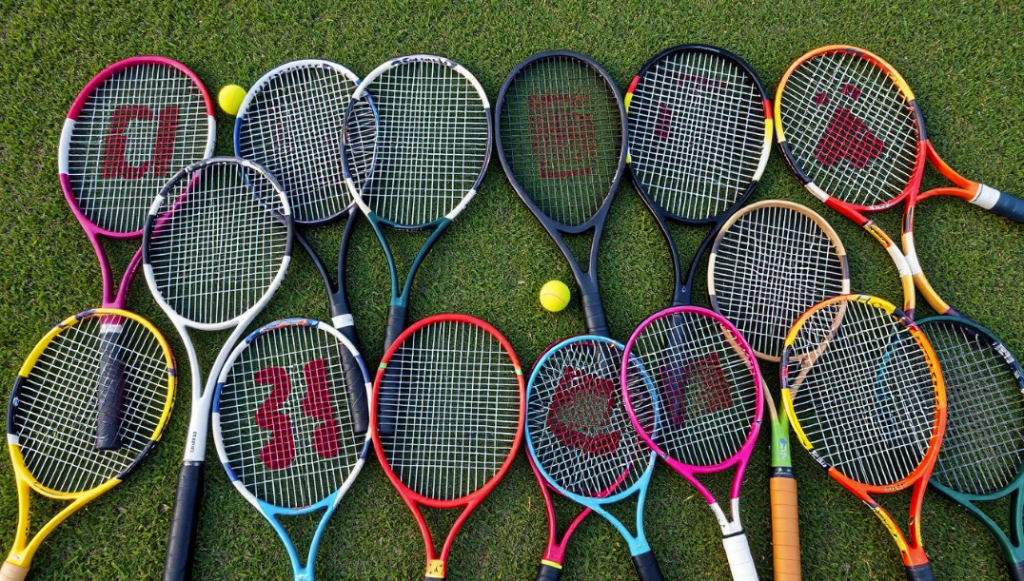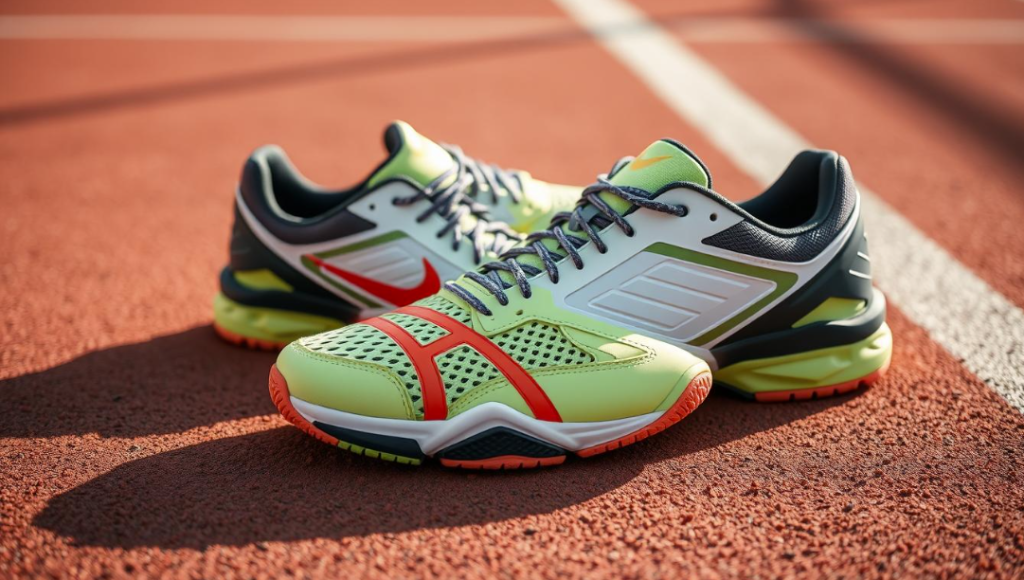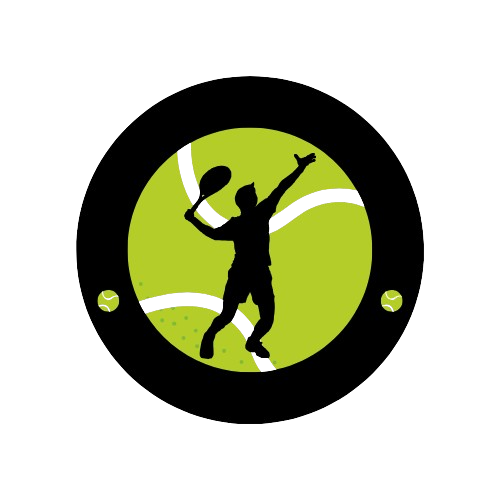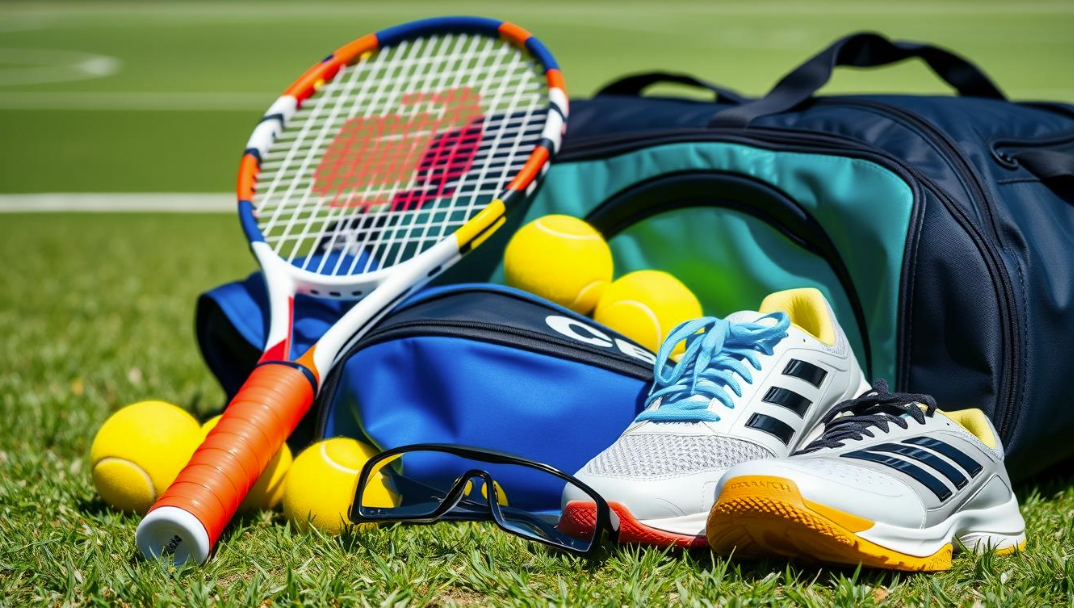Did you know a basic tennis racquet costs about $100? But a top-notch racquet can be as high as $400? It’s important for new players to know what they need to start playing tennis. This guide will help you get the right gear, whether you’re celebrating National Tennis Month or just starting out.
Tennis is a sport that lasts a lifetime, offering health and mental benefits. Beginners need a racquet, fresh balls, and the right shoes. You can find a good racquet for under $100. Tennis shoes support your body during the sport’s unique movements. And, fresh balls make the game more fun.

Key Takeaways
- Tennis is a lifelong sport with numerous health and mental benefits.
- Essential beginner equipment includes a racquet, tennis balls, and proper footwear.
- Beginner racquets can be found for under $100, while high-end models can cost up to $400.
- Tennis shoes should be replaced every 3-6 months for active players.
- Fresh tennis balls are crucial for an enjoyable playing experience.
Essential Tennis Equipment for Beginners
Starting your tennis journey means getting the right gear. You’ll need a tennis racket, balls, and shoes. These basics help you learn and enjoy the game.
Understanding Basic Equipment Requirements
A quality tennis racket is key. Beginners often choose a pre-strung racket under $100. It’s a solid choice as you learn.
Tennis balls come in cans of three. There are regular duty for soft courts and extra duty for hard ones. This meets different playing needs.
Tennis shoes are vital for safety and performance. They cost less than $100. These shoes offer the right cushioning and support for tennis moves.
Cost Considerations for New Players
Starting out, it’s smart to budget for your gear. A beginner-friendly racket, balls, and shoes can cost around $100 each. This lets new players focus on improving without spending too much.
Where to Buy Tennis Equipment
You can find tennis gear in local shops, sports stores, and online. These places have a wide range of rackets, balls, shoes, and accessories. Whether you like in-store advice or online shopping, there’s plenty of options to start your tennis journey.

“The right equipment can make all the difference in the early stages of your tennis journey. Invest in quality basics to build a strong foundation for your game.”
Choosing Your First Tennis Racquet
The racquet is key for beginners in tennis. It affects your power, control, and comfort. The right racquet helps you enjoy the game and get better.
Power vs Control Racquets
Racquets are either power racquets or control racquets. Beginners should choose power racquets. They are light and powerful. Experienced players prefer control racquets for precision.
Grip Size and Racquet Length
Finding the right grip size is crucial. Most racquets are 4 to 4 ⅝ inches. Women usually need a 4 ¼ inch grip. Adult racquets are 27 inches long, but juniors have shorter options.
Budget-Friendly Options for Beginners
Start with a racquet that’s easy on your wallet. You can find good beginner racquets for $60. Junior racquets are even cheaper, around $30. As you get better, you can upgrade to a racquet that fits your new skills.
| Racquet Type | Head Size | Weight | Price Range |
| Power Racquet | 106-115 sq. in. | 240g – 265g | $60 – $120 |
| Control Racquet | 95-100 sq. in. | 285g – 305g | $100 – $300 |
Look for a racquet that balances power, control, and comfort. It should also fit your budget. By considering these factors, you’ll find the perfect racquet for your tennis journey.

Tennis Shoes and Court-Specific Footwear
The right shoes are key for tennis. They offer support and stability for the sport’s unique movements. This includes lateral stability and quick changes of direction.
Think about the court surface you’ll play on. Different surfaces need specific shoe features. For example, clay court shoes have a herringbone tread for grip on soft surfaces. Hard court shoes are more durable for abrasive surfaces. Grass court shoes have small nubs for better grip on slippery grass.
Don’t use regular running shoes for tennis. They don’t offer the needed support and stability. Cross-training shoes can work for beginners, but they’re not as good as tennis shoes.
| Court Surface | Shoe Features | Average Replacement Frequency |
| Clay | Herringbone tread pattern for grip | Every 3-6 months |
| Hard | Durable outsoles to withstand abrasive surfaces | Every year |
| Grass | Small nubs or bumps on the soles for traction | Every 6 months |
Investing in quality tennis shoes for your court surface can improve your game. It also helps prevent injuries. Whether you’re new or experienced, the right shoes are essential for your tennis gear.

Tennis Balls: Types and Selection Guide
Tennis balls are as crucial as rackets in the game. They come in different types, each with its own features and uses. Knowing the differences between pressurized, non-pressurized, and training balls helps you choose the right one for your game.
Pressurized vs. Non-Pressurized Balls
Most players use pressurized tennis balls for their games. These balls are filled with air and bounce well for a while. Pressurized balls bounce more and games move faster, but they wear out faster. Non-pressurized balls, on the other hand, last longer. They have thicker walls and a unique sound, making them great for beginners.
Training Balls for Beginners
Beginners and young players benefit from training balls. These balls, like Dunlop Stage 1 and Dunlop Australian Open regular duty balls, help new players build skills without feeling overwhelmed. The USTA suggests the right training balls based on age and skill level.
Ball Durability and Maintenance
For frequent players, ball durability is key. Extra-duty balls last longer on hard courts, while regular-duty balls are better for clay. Keeping balls in a pressurized container and replacing them often ensures a good game.
“Selecting the right tennis balls can make a significant difference in your game, whether you’re a beginner or a seasoned player.”
| Ball Type | Suitable Court Surface | Durability | Recommended Player Level |
| Extra-Duty | Hard Courts | High | Intermediate to Advanced |
| Regular-Duty | Clay Courts | Moderate | Beginner to Intermediate |
| Pressureless | All Court Types | High | Beginner to Recreational |
| Training Balls | All Court Types | Moderate | Beginner |
Tennis Equipment Guide: What Every Beginner Needs
As a beginner tennis player, having the right equipment is key. It makes playing more fun and helps you play better. This guide will show you what you need, from the best racquet to the right shoes.
The Tennis Racquet: Finding the Right Fit
Beginners should look for a racquet that balances power and control. Our research shows that a basic racquet costs about $100, while top models can be up to $400. Brands like Wilson, Head, and Babolat offer a wide range for all players.
Choose a racquet with a head size over 100 square inches for more power. The right grip size is also important. A grip that’s too small can cause control issues, while a too-large grip can be uncomfortable.
Tennis Shoes: Tailored for the Court
Good tennis shoes are vital for safety and performance. Each court type, like clay, hard, and grass, needs specific shoes for the best grip and support. Shoes must also be durable to handle quick movements and stops. The weight and cushioning of your shoes affect your speed and comfort.
Tennis Balls: Keeping the Game Fresh
High-quality tennis balls are essential for a great game. There are over 100 tennis ball brands, divided into standard, championship, and professional types. Pressurized balls are fast but lose speed quickly. Non-pressurized balls are heavier but last longer and get better with use.
Essential Accessories for Beginner Tennis Players
Don’t forget these accessories to complete your gear:
- Tennis towel: Lightweight and highly absorbent, designed for better performance during matches.
- Sun protection: Suitable sun cream to protect your skin from harmful UV rays during outdoor play.
- Hydration and nutrition: Energy drinks and bars to maintain energy levels and stay hydrated.
- Racket grips and overgrips: For added comfort and sweat absorption during play.
Investing in the right equipment will help you enjoy tennis more and improve your skills. Choose gear that fits your budget, playing style, and the court you play on.
Tennis Apparel and Dress Codes
Comfort and performance are key in tennis attire. Tennis clothes are like athletic wear but with special designs. They need to be breathable, wick moisture, and move freely.
Comfort and Performance Clothing
Today’s tennis clothes are all about being practical and functional. Women’s tennis wear includes polo shirts, tank tops, skirts, dresses, and skirts or shorts with shorts underneath. Men wear polo shirts with collars and short sleeves, or sleeveless shirts.
Thanks to new fabrics and designs, tennis clothes are more comfortable and supportive. The right shoes are also important, as they need to grip the court well.
Weather-Appropriate Gear
Tennis is played in many weather conditions. So, it’s important to have the right clothes. In cool weather, wear layers and moisture-wicking fabrics to stay warm and dry. In hot weather, choose lightweight, breathable clothes to manage sweat.
Wearing hats, visors, and sports sunglasses helps protect from the sun. Use sunscreen with at least SPF 15 to prevent skin damage from UV rays.
| Tennis Apparel Trends | Key Considerations |
| – Increased popularity of shorts and leggings for women – Layering for colder conditions in professional tennis – Predominant use of white clothing at Wimbledon | – Comfort and breathability – Compliance with dress codes (e.g., collared shirts, all-white attire) – Appropriate footwear for court surface |
Tennis clothes and dress codes are always changing. They focus on performance, comfort, and following rules. Knowing the latest trends helps players enjoy tennis more, both on and off the court.
Tennis Bags and Storage Solutions
Choosing the right tennis bag is key for keeping your gear organized. Quality bags, like the Cancha racquet bag, are durable and water-resistant. They have many compartments to keep your stuff safe and easy to find.
Think about how many racquets you need to carry. A 6-racket bag is perfect for most players. It has enough room for racquets, clothes, shoes, and accessories. Look for bags with insulated pockets for drinks and ventilated areas to manage odors.
For those who string their own racquets, a bag with a special stringing machine pocket is great. Keeping your tennis gear, including racquets and balls, in good shape is important. It helps you play your best.
Hydration and Accessories
Staying hydrated is vital for tennis players, especially during long games. Make sure to bring a water bottle or sports drink. Use a hydration schedule to stay at your best.
Microfiber towels are also a must. They help keep you dry and comfortable on the court.
Bag Styles and Features
Tennis bags come in many styles, like backpacks and tote bags. The Hulken tote bag is a great choice. It can hold up to 12 racquets and has strong stitching and zippers.
It also has adjustable straps for comfort. The bag’s design makes organizing your gear easy. Plus, it has wheels for easy moving.
Whether you play competitively or just for fun, a good tennis bag is essential. It keeps your gear safe, helps you stay organized, and makes playing tennis better.
Essential Tennis Accessories and Add-ons
As a beginner tennis player, getting the right accessories can really boost your game. You don’t just need a racquet and shoes. There are many other add-ons that can make your tennis experience better and more fun.
Grips and Overgrips
A good tennis grip is key for control and comfort. Overgrips, thin layers on top of your grip, add extra cushioning. They help prevent blisters and improve your grip.
Vibration Dampeners
Vibration dampeners are small devices for your racquet strings. They reduce vibration, easing strain on your arm and wrist. This is especially helpful for powerful shots.
Protective Equipment
Wearing protective gear like wristbands and sunvisors is important. Wristbands keep sweat away and prevent chafing. Sunvisors protect your eyes from glare, helping you stay focused.
Don’t forget a water bottle, a lightweight towel, and energy bars or drinks. These tennis accessories and add-ons can make your game more comfortable and enjoyable.
Conclusion
Tennis is a sport for everyone, from kids to seniors. It’s great for your health and can be played safely with others. You don’t need to spend a lot to start playing.
For beginners, you’ll need a good racquet, the right shoes, fresh balls, and some basic gear. With the right stuff and a positive mindset, you can enjoy tennis and maybe even love it for life. Knowing what to look for in equipment helps beginners start their tennis adventure with confidence.
Whether you’re young or an adult, tennis is waiting for you. With the right gear and a desire to learn, it’s a sport that offers joy and fulfillment. So, pick up your racket, put on your shoes, and get ready for fun on the court!
FAQ
What are the essential tennis equipment items for beginners?
Beginners need a racquet, fresh balls, and the right tennis shoes. A racquet under $100 is a good start. Tennis shoes offer support and stability for the sport’s movements. Fresh balls make the game more fun.
How do I choose the right tennis racquet for a beginner?
Racquets are sorted by head size, weight, length, and stiffness. Beginners should look for power racquets with large heads and light weight. Experienced players prefer control racquets. “Tweener” racquets offer a balance for intermediate players.
Adult racquets are 27 inches long, with shorter ones for juniors. The right grip size is key for comfort and performance.
What type of tennis shoes should a beginner wear?
Beginners need tennis-specific shoes for support during the game. Shoes vary for different court surfaces: clay, hard, and grass. Clay court shoes have herringbone patterns for grip.
Hard court shoes are durable, and grass court shoes have small bumps for traction. Running shoes are not good for tennis because they lack lateral support.
How do I choose the right tennis balls for a beginner?
Tennis balls come in pressurized and non-pressurized types. Pressurized balls are better for play but wear out fast. Non-pressurized balls last longer.
Regular Duty balls are for clay courts, and Extra Duty balls are for hard courts. Training balls with lower bounce and slower travel are good for young players. Fresh balls are essential for a good game.
What other essential tennis accessories should a beginner consider?
Beginners should get grips and overgrips for better racquet handling. Vibration dampeners reduce string vibration. Protective gear like wristbands and sunvisors is also important.
A water bottle keeps you hydrated, and court towels are lightweight and absorbent.

